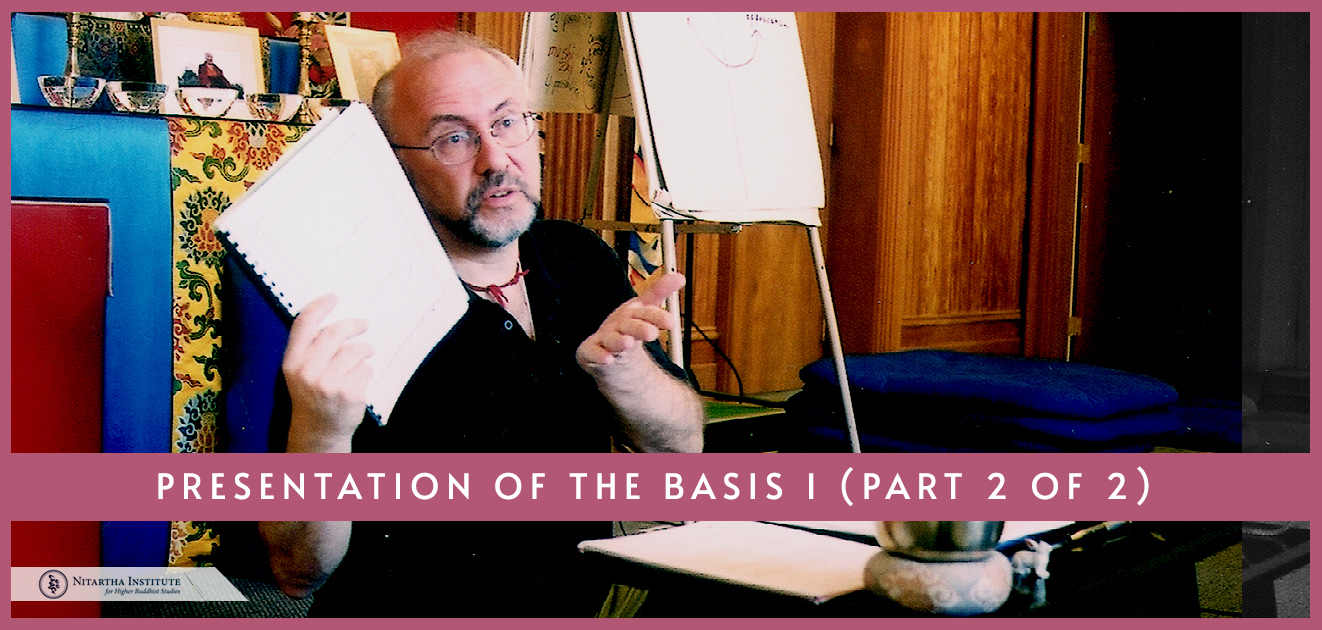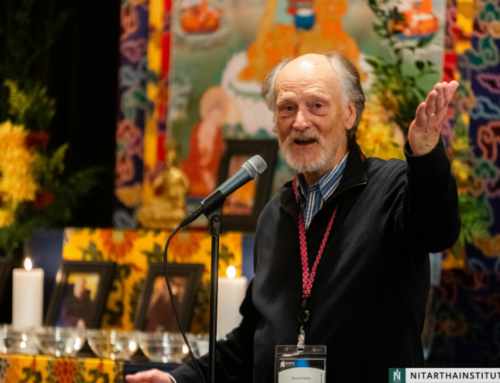This excerpt is copyrighted material, please do not use or copy without written permission from Nitartha Publications.
This is an excerpt from the sourcebook we use in our Mind & Its World II class. Mind & Its World II explores the criteria of valid cognition based on the teachings of the Pramāna tradition, or Buddhist epistemology. We will analyze our consciousness and determine to what degree it is in agreement with its observed object or not; what the difference is between non-mistaken, non-deceiving, conceptual and non-conceptual types of awareness. Practically speaking, this also provides the practitioner with the tools for delineating conceptual and nonconceptual types of mind in meditation.
PRESENTATION OF THE BASIS I (Part 2 of 2)
Scott Wallenbach
PRESENTATION OF THE BASIS I
-SCOTT WELLENBACH
THREE LEVELS OF ANALYSIS
Now I want to look at a point of controversy concerning specifically characterized phenomena. It is generally said that for the Sautrantikas who follow reasoning that gross objects, like vases, are specifically characterized because they perform a function. However, at certain points in the Treasury of Knowledge, Jamgön Kongtrül denies that gross objects are specifically characterized. Similar in certain respects (but only in part) to the position of the Vaibhaṣhikas concerning the ultimate truth, in these passages he says that only partless particles are specifically characterized. They are what really performs a function. Both of these positions are found in Dharmakirti writings in different places. Was he confused? Probably not. Rather, it is a question of levels of analysis.
The Vaibhaṣhikas say that all phenomena are things. So all phenomena perform a function, including what the Sautrantikas call generally characterized phenomena, the content of our thinking mind. Now Dharmakirti comes along and says let’s look at our mind more closely. What performs a function is the part of mind that is thinking, the thinker, but the content of our thought does not perform a function. There is a real difference between the thought “a drink of water” and having a drink of water. One does not physically quench your thirst; the other does. As someone trying to make sense of our world, the first cut he makes is between what is actually doing something, be it a physical thing or a mind, and what is imaginary. From that point of view, vases do perform a function, as opposed to our concept of a vase. That is the distinction being made at this first level of analysis: a vase is said to be specifically characterized; the idea of a vase is generally characterized.
In other places in his writing, Dharmakirti takes a different position. We can question which sense consciousness experiences a vase. If we go through the Collected Topics, we will not find a vase in the classifications of phenomena. What does the eye consciousness experience? It experiences shape and color. We generally do not smell, hear, or taste vases, but we do touch them. What does the tactile sense consciousness experience?
It experiences hardness, softness, smoothness, and so on. But we do not see a vase in those classifications. The Collected Topics does not say that we see banners, pillars, vases, tables, and chairs; rather, it says that we see shape and color. So where did the idea come from that gross objects are real things that can be directly cognized? Dharmakirti says that we see color and shape, and maybe we feel smoothness if we touch it, and then we put that data together and label it “vase.” So a gross object is simply our concept. From that point of view, and by the way, this is sometimes known as the alternative interpretation of Dharmakirti, what is really specifically characterized, what really performs a function, is that level of color and shape—what are called sensibilia, or patches of experience, for instance a red hue in a certain spatial configuration and a feeling of hardness—but not gross objects. The construction of gross objects is the function of our conceptual mind. This is the second level of analysis.
Even more basically, in other places Dharmakirti says that it is not sensibilia that really exist, it is partless particles and indivisible moments of mind. It comes down ultimately to a similar position to the Vaibhaṣhikas, although the Sautrantikas are even more radical in their position as we will see. In what is sometimes called the standard interpretation of Dharmakirti, it is partless particles and indivisible moments of mind that are specifically characterized. This is the third level of analysis.
These levels of analysis can be useful. In exploring these topics for oneself and in particular trying to convey to others how we are looking at experience, it can make sense to first draw the distinction between this bottle, for example, and our thought of the bottle. Second, we ask ourselves to look at the bottle. Do we really see a bottle? No, we see color and shape. That is what is real. Third, we are asked to investigate further and see if even these patches of color and shape are real or we can find something even more basic. At each level, our analysis gets finer and finer. In this text, we are on the level of the first cut. Nevertheless, just to be clear, leaving Dharmakirti aside, in the Tibetan tradition in general, the standard examples of specifically characterized phenomena are gross objects, such as vases.
Different defining characteristics in a later moment compared to a previous moment means aging. The Sautrantikas assert that these four defining characteristics of conditioned phenomena are established at the same time.
PERMANENT & IMPERMANENT PHENOMENA
The Vaibhaṣhika believe in impermanence, no question about it, but there is a distinction made between the object itself and its arising, its abiding, its aging, and its ceasing. Those four processes are nonassociated formations. The Vaibhaṣhikas say that, for example, the impermanence of the water bottle is distinct from the water bottle itself. Secondly, the arising of the thing, its abiding, its deteriorating, and its perishing are all discrete, impermanent, conditioned phenomena. Their set of causes come from outside. In other words, they are not intrinsic to the thing itself. How does a plant come to be? Causes and conditions come together, the seed, water, sunlight, all its conditions, to produce its arising. That plant will abide and it will age, but its aging will be due to factors external to the plant itself. Its abiding is the time between its arising and ceasing, and its ceasing will also be caused by factors external to the plant itself, like winter or a windstorm. That is the Vaibhaṣhika view. The Sautrantikas also assert impermanence, but have a somewhat different understanding of what that means. To understand impermanence, it is useful to take a look at what Buddhists means by “permanence.” Sometimes the word “permanence” is used in the way we usually think of it—“everlasting” or “eternal.” However, there is another sense of permanence that is often found in the literature of the philosophical systems: it means anything that lasts for more than one moment. Whatever abides for more than one moment is said to be permanent, such as thoughts, the objects of our conceptual mind. It is in that sense that generally characterized phenomena are permanent, not that they are eternal. The Sautrantikas looking at the Vaibhaṣhika position said, “Of course, what you are describing is impermanence, but if you really look closely, a subtle level of permanence has snuck into your system. Something arises in a moment and abides for a while, perhaps say for a few moments, and then it ceases. That abiding is a subtle permanence: that impermanence is not a radical impermanence.” The Sautrantikas want to make two points. They agree that the arising of a phenomenon is due to external conditions, but the so-called abiding, the so-called aging, and the so-called ceasing do not have their own set of external conditions. They are intrinsic to the phenomenon itself. So the Sautrantikas say that the qualities that the Vaibhaṣhikas thought were separate from the thing are just a part of what we mean by an impermanent object. The second point is that arising, abiding, and ceasing all happen in one moment. The arising of the object or moment of consciousness is its abiding and it is its ceasing. It does not arise in one moment, abide in the next, and then cease in a third moment. It just flashes. Of course, from that point of view, abiding and ceasing do not have their own separate, external causes that make the thing whither or die, because they are contained in the thing itself. It is not even there long enough for external causes to bear upon it.
The texts says, “The Sautrantikas assert the defining characteristics of conditioned phenomena—such as arising—with respect to the process of arising, the process of abiding, and the process of perishing. The collection of such features as a hump and a dewlap constitutes the defining characteristics of an Indian ox, but they are not substances other than the ox. In the same way, arising and such are not substances that are something other than form and so on.” It is not like the hump of the ox is a different thing. It is a part of what we mean by ox, at least an Indian one, and this is exactly the same as arising, abiding, and ceasing. They are intrinsic to the phenomenon.
The next paragraph is interesting. “New occurrences, such things as a sprout that did not exist before is arising.” A new occurrence is something we did not see before and now we do. That is arising. “Abiding of a previous type is abiding.” The thing flashes into existence in every moment, and if it is the same type—this sprout, this sprout, this sprout, this sprout— if its continuum of moments are more or less the same, that
is what we call abiding. “Not remaining for a second moment except for the time of coming into existence is perishing.” It does not remain for a second moment. The very moment it comes into existence, it ceases as well.
Then the text says, “Different defining characteristics in a later moment compared to a previous moment means aging. The Sautrantikas assert that these four defining characteristics of conditioned phenomena are established at the same time. Hence, a thing that consists of the collection of its causes and conditions and is conditioned by them is just the mere moment of its arising. One is not able to express the nature of arising and the nature of perishing as something different. Therefore, a thing is something that is produced through its own specific causes as something that has the character of perishing, but it is not something that is produced as something stable. Thus, one should understand a thing as just something that perishes immediately after the moment in time when it comes into existence and does not remain for a second moment beyond that.” Everything is right there. What we mean by aging or withering or deteriorating is that we are comparing different moments of the continuum of thing and noticing the differences.





